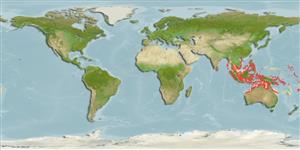>
Atheriniformes (Silversides) >
Atherinidae (Silversides) > Atherinomorinae
Etymology: Atherinomorus: Greek, atherina, the Greek name for the eperlane + Greek, moros = silly, stupid (Ref. 45335).
More on authors: Quoy & Gaimard.
Environment: milieu / climate zone / depth range / distribution range
Ecologia
marino; salmastro associati a barriera corallina. Tropical; 19°N - 24°S
Western Central Pacific: Philippines and Micronesia to northern Australia and the Solomon Islands.
Size / Peso / Age
Maturity: Lm ? range ? - ? cm
Max length : 9.0 cm SL maschio/sesso non determinato; (Ref. 1602)
Spine dorsali (totale) : 5 - 7; Raggi dorsali molli (totale) : 8 - 10; Spine anali: 1; Raggi anali molli: 11 - 14. Pectoral blotch, when present, distinct; midlateral band silvery (Ref. 9760). Ramus of premaxilla not extending past vertical through anterior border of pupil; Free edge of lower jaw sloping backwards and upwards and with distinct tubercle at posterior end.
Found in shallow coastal waters. Schools with A. lacunosus, A. ogilbyi, Craterocephalus mugiloides, and Hypoatherina temminckii, in the coasts of northern Australia.
Life cycle and mating behavior
Maturità | Riproduzione | Deposizione | Uova | Fecundity | Larve
Ivantsoff, W. and L.E.L.M. Crowley, 1991. Review of the Australian silverside fishes of the genus Atherinomorus (Atherinidae). Aust. J. Mar. Freshwat. Res. 42(5):479-505. (Ref. 2909)
IUCN Red List Status (Ref. 130435: Version 2024-1)
Threat to humans
Harmless
Human uses
Pesca: di nessun interesse
Strumenti
Special reports
Download XML
Fonti Internet
Estimates based on models
Preferred temperature (Ref.
123201): 26.7 - 29.1, mean 28.3 °C (based on 890 cells).
Phylogenetic diversity index (Ref.
82804): PD
50 = 0.5005 [Uniqueness, from 0.5 = low to 2.0 = high].
Bayesian length-weight: a=0.00562 (0.00240 - 0.01320), b=3.15 (2.95 - 3.35), in cm total length, based on LWR estimates for this (Sub)family-body shape (Ref.
93245).
Trophic level (Ref.
69278): 3.4 ±0.45 se; based on food items.
Resilienza (Ref.
120179): Alto, tempo minimo di raddoppiamento della popolazione meno di 15 mesi (Preliminary K or Fecundity.).
Fishing Vulnerability (Ref.
59153): Low vulnerability (10 of 100).
Nutrients (Ref.
124155): Calcium = 123 [65, 251] mg/100g; Iron = 0.807 [0.440, 1.416] mg/100g; Protein = 19.4 [17.0, 21.8] %; Omega3 = 0.15 [0.06, 0.38] g/100g; Selenium = 17.7 [8.0, 43.5] μg/100g; VitaminA = 307 [98, 940] μg/100g; Zinc = 2.17 [1.39, 3.19] mg/100g (wet weight);
